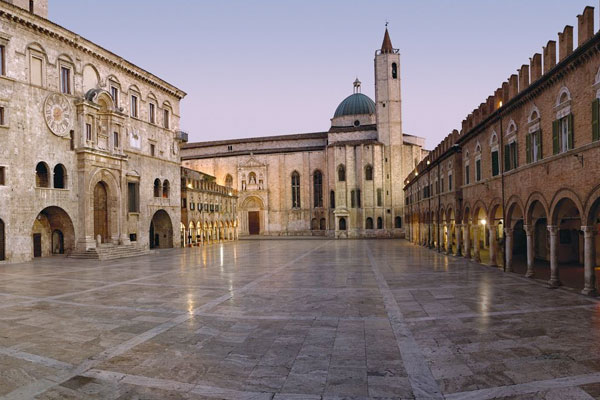
Die Gebäude, Straßen und Plätze, die sie kenn sagen seine alte Geschichte: von den Fassaden der Häuser der mittelalterlichen Layout-Raster von Straßen und Wegen, die es ausmachen. Ascoli Piceno ist eine Stadt der Kunst, Kultur, starke Traditionen. Harmonie und Zusammenhalt sind die Aspekte, die das Stadtbild prägen. Der Verdienst ist aus Travertin, einem seit ihrer Entstehung in der Errichtung von Gebäuden verschiedener Art Material: von einfachen Wohnungen zu Palästen, von den Kirchen in die Pflasterung der Straßen. Zwei sind die Nervenzentren der Ascoli antike und die moderne, Piazza del Popolo und der Piazza Arringo. Die erste war die Stelle des alten Forums und die Residenz der Captains der Menschen, sowie die aktive Handelszentrum, das zweite jedoch war die politische Herz der Stadt mit der Kathedrale und der Bischofspalast. Viele der für die Museen der Stadt sind auf dem Platz Arringo konzentriert, nicht überraschend als “Museumsplatz”. Sind in ihm vorhanden: die Gemäldegalerie, die zahlreiche Kunstwerke, wie Tizian, Guido Reni und Joseph Pellizza Volpedo, Diözesanmuseum und der Staats Archäologische Museum enthält. Die historische Stadt ist bekannt durch den Stich des Flusses Tronto und seinem Nebenfluss Castellano, während die neue Stadt erstreckt sich nach Osten geschützt, nach dem Durchlauf des Tronto bis zum Meer. Faszinierend ist die Strecke zwischen den Orten der Anbetung in der Stadt, die in der Kirche von St. Thomas beginnen können, bis Sie zur Kirche S. Maria Intervineas bekommen, Überschreiten der anderen vierzehn romanischen Kirchen, die neben dem Baptisterium, der Ascoli Piceno zu charakterisieren. Dieses Land hat eine große Theatertradition; Ich bin Zeuge der verschiedenen Theatern im neunzehnten Jahrhundert als Philharmonikern, dem Ventidio Basso, der Aula des heiligen Franziskus von Paola gebaut. Die strategisch günstige geographische Lage von Ascoli Piceno können Sie die Sibillini-Nationalpark, der Nationalpark Gran Sasso-Laga und den oberen Teil des Sibyl besuchen. Nicht weit von der Stadt liegt auch Monte Christi Himmelfahrt, religiösen Pilgerfahrt im Mittelalter, die noch einen Blick von Heiligkeit bewahrt. Jedes Jahr, in der Tat, im Laufe des Monats Mai, Tausende von Menschen den Berg besteigen, um das Fest der Himmelfahrt, anlässlich der Übergabe der Madonna von Polesio die Kirche auf dem Gipfel errichtet. Der Umzug von Ascoli nach San Benedetto del Tronto treffen charakteristischen Orte, wie Offida, mit den Überresten der Burg fünfzehnten. Einblicke in mittelalterliche liegen stattdessen in Ripatransone, auch “Sicht des Piceno” für seine landschaftliche Lage. Unter dem Meer, erinnere mich an die engen Gassen von Grottammare und San Benedetto del Tronto, mit Sandstrand.

